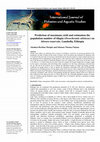Papers by ALEMKEN B E R I H U N MENGIST
Fisheries and aquatic sciences, Apr 1, 2024
The study was conducted at Lake Hayq, one of the lakes of Wollo, Ethiopia. Data were collected at... more The study was conducted at Lake Hayq, one of the lakes of Wollo, Ethiopia. Data were collected at the landing sites for 365 days (June 8, 2022 to June 7, 2023). The basic information gathered in the fishing part of the Lake was Nile tilapia caught by fishermen, the total number of tilapia and the increase in fishing effort. The aim of the research was to estimate the size of the Nile tilapia population and the fishing mortality rate in length groups for Nile tilapia stocks occurring in the lake. A Jones length-based cohort analysis model was used to estimate Nile tilapia population. The estimated Nile tilapia population was over 46.8 Million tilapia per year. The model estimates that more than 13.3 million 8-10 cm Nile tilapia are caught in fisheries each year.
The study was conducted at Lake Hayq, one of the lakes of Wollo, Ethiopia. Data were collected at... more The study was conducted at Lake Hayq, one of the lakes of Wollo, Ethiopia. Data were collected at the landing sites for 365 days (June 8, 2022 to June 7, 2023). The basic information gathered in the fishing part of the Lake was Nile tilapia caught by fishermen, the total number of tilapia and the increase in fishing effort. The aim of the research was to estimate the size of the Nile tilapia population and the fishing mortality rate in length groups for Nile tilapia stocks occurring in the lake. A Jones length-based cohort analysis model was used to estimate Nile tilapia population. The estimated Nile tilapia population was over 46.8 Million tilapia per year. The model estimates that more than 13.3 million 8-10 cm Nile tilapia are caught in fisheries each year.

International Journal of Hospitality & Tourism Management, 2019
Tourism has been emerged as one of the effective tools in eradicating poverty. Ethiopia has huge ... more Tourism has been emerged as one of the effective tools in eradicating poverty. Ethiopia has huge tourism potentials like natural, non-natural, historical and cultural resources. Gambella Region is one of the attractive tourismdestinations located at South West of Ethiopia. But, its tourism industry development is in infant stage. Nonetheless, limited study has carried out on identifying opportunities. Hence, the main objective of this study was identifying opportunities to enhance tourism industry development in the Region. To do so, key informants from three zones, five regional offices and thirteen woredas has purposively selected based on the defined criteria. Altogether, 103 key informants were interviewed besides to field observation. The collected firsthand data were edited, categorized, arranged and organized and encoded into SPSS software version 20. Qualitative data was being analyzed in meaningful content description whereas quantitative data was being analyzed in numerical values. Findings of this study revealed that recruiting trained human power, organizing local tour guide associations, making linkage with tour operators, developing tourist guidebook, installing tourist information centers, enhancing promotion and marketing of tourism destinations, information update, improving infrastructures development, and installing accommodation deliverers are the major opportunities to enhance tourism industry development in the Region.

International Journal of Tourism & Hospitality Reviews, 2019
Purpose – the purpose of this study was to identify ecotourism potentials of the Majang Forest Bi... more Purpose – the purpose of this study was to identify ecotourism potentials of the Majang Forest Biosphere Reserve. Methodology – The study employed qualitative research approach using an exploratory research design. Data was collected through in-depth interviews and focus group discussion besides to field observations. Accordingly, key informants interviewees were held with 12 villages senior leaders (n=60), key informants from 6 departments (n=30) and NGO experts (n=5). Altogether, 95 respondents were involved in this study Findings – The results of this research revealed that fauna and flora (87%), water bodies (waterfalls, rivers, and lakes) (82%), cultural attractions (54%), manmade attractions as well as historical sites are found to be the major ecotourism potentials of the Biosphere Reserve. Originality – The study provides complied information of ecotourism potentials of the Majang Forest Biosphere Reserve, which has not been explored before. It enhances the concept of ecotou...

International Journal of Scientific and Research Publications (IJSRP), 2019
Tourism is travel for recreation, leisure, education and training, visiting friends and relatives... more Tourism is travel for recreation, leisure, education and training, visiting friends and relatives, shopping, transit, pilgrimages or business purposes and staying in places outside their usual environment for not less than 24 hours and not more than one consecutive year. The tourism industry is made up attraction sector, accommodation sector and transport sector. Ethiopia embraces enormous natural tourism potentials with its unique biodiversity, spectacular landscapes, lakes, waterfalls, rivers, mountains, cliffs, natural bridges, valleys, protected areas and biosphere reserves. Gambella Region is located at south west of Ethiopia and endowed with remarkable natural tourism destinations. Nonetheless, limited study has conducted in exploring natural tourism potentials. Henceforth, the current study addresses the stated issue. To do so, key informants from three zones (n=15), five regional offices (n=23) and 13 woredas (n=65) has purposively selected based on the set criteria. Altogether, 103 key informants were interviewed besides to field observation. Collected raw data were chosen, refined, categorized, edited, evaluated, coded and entered to SPSS software version 20. Descriptive statistics were computed for relevant variables and information obtained from the key informants and field observation was described in meaningful content. Findings of this study revealed that Gambella Region has endowed with marvelous natural tourism potentials like waterfalls, lakes, rivers, mountains, bridges, wetlands, national park and biosphere reserve. Key informants underlined that the region has delightful natural potential to attract tourists, ecologists, environmentalists, explorers, drifters, naturalist and other segment of tourists towards its unique biodiversity from the different corner of the world.

Tourism is a circulation of people who travel to or stay in places outside their home country. It... more Tourism is a circulation of people who travel to or stay in places outside their home country. It has being believed as a major ingredient in the economic development strategy. However, various external and internal factors have been affecting the sustainable development of the tourism industry worldwide. Although Ethiopia possesses numerous natural, religious, historical, non-natural and cultural tourism attractions, economic contribution and its potential are incomparable. Shortage of tourist facilities, lack of skillful human resources, weak promotion, lack of integration and political will are the major negatively contributing forces. Although Ethiopia possesses massive tourism development potentials with its unique biodiversity and spectacular topographic features, its economic contribution to the country is unmatched. Similarly Gambella Region has endowed with tourism potentials. But, its tourism industry development is in an infant stage. Nevertheless a limited study has done...

International Journal of Fisheries and Aquatic Studies, 2020
Global water bodies are suffering from excessive overfishing, exerted by an increasing demand of ... more Global water bodies are suffering from excessive overfishing, exerted by an increasing demand of the population. In order to follow up the status of fishery, stock assessment and estimation of optimum yield is needed for the provision of necessary information for the decision makers to make rational decision on the optimum level of exploitation of fish resources. This study has been conducted on Alwero Reservior one of the Reservoirs found in Gambella Ethiopia. Data was collected on a daily basis for 60 days (from 1-10-2019 to 1-12-2019) from the area where fish were landed. The length composition of tilapia caught by the fishery, total tilapia yield and fishing effort expanded were the basic information collected from the site The aim of the analysis was to estimate the population number of tilapia and fishing mortality coefficient by length group as well as predict the maximum sustainable fish yield and biologically optimum level of fishing pressure for the tilapia stock of the re...

Momona Ethiopian Journal of Science
The tilapia (Oreochromis niloticus, L. 1758) stock of Lake Hawassa, Ethiopia, was assessed to est... more The tilapia (Oreochromis niloticus, L. 1758) stock of Lake Hawassa, Ethiopia, was assessed to estimate sustainable yield (MSY) and optimum fishing effort (f opt) using length-based analytical models (Jone's cohort analysis and Thompson and Bell). Pertinent data (length, weight, catch, effort, etc.) were collected on a daily basis for 514 days during 27-12-2003 to 24-05-2005 at the major landing site known as Fish market or AmoraGedel. The sampling days fell into two periods demarcated by the date (08-04-2004) when a management action was implemented, which reduced fishing effort by half (from1954 gillnets/day to below 800 nets/day). Thus, data obtained during 27-12-2003 to 08-04-2004 pertained to the period prior to effort reduction whereas the rest pertained to the period after the reduction. The two data sets were analyzed separately to get a basis to evaluate the effect of the management action of effort reduction. The assessment gave an estimate of current yield of 526.8 t/year for the period before effort reduction whereas 441.6 t/year afterward. The predicted MSY was 514.5 t/year and 441.6 t/year for the period before and after effort reduction, respectively. The respective F-factor is estimated to be 0.5 and 1.0.This suggested that the fishing effort before the reduction of effort (1954nets/day) was very high and, as already implemented, should have been reduced by half(i.e., an F-factor of 0.5).Therefore, the implemented management measure to reduce effort below 800 nets/day is appropriate. Likewise, since the estimated MSY of441.6 t/year for the period after the reduction would be obtained at an F-factor of 1.0, it was concluded that the current level of fishing effort of 696 gillnets/day can be maintained as f opt for sustainable exploitation of the stock.

International Journal of Fisheries and Aquatic Studies, 2020
Global water bodies are suffering from excessive overfishing, exerted by an increasing demand of ... more Global water bodies are suffering from excessive overfishing, exerted by an increasing demand of the population. In order to follow up the status of fishery, stock assessment and estimation of optimum yield is needed for the provision of necessary information for the decision makers to make rational decision on the optimum level of exploitation of fish resources. This study has been conducted on Alwero Reservior one of the Reservoirs found in Gambella Ethiopia. Data was collected on a daily basis for 60 days (from 1-10-2019 to 1-12-2019) from the area where fish were landed. The length composition of tilapia caught by the fishery, total tilapia yield and fishing effort expanded were the basic information collected from the site The aim of the analysis was to estimate the population number of tilapia and fishing mortality coefficient by length group as well as predict the maximum sustainable fish yield and biologically optimum level of fishing pressure for the tilapia stock of the reservoir. Jones length based cohort analysis Model and length-based Thompson and Bell yield Prediction Model have been employed to estimate the maximum sustainable yield with the corresponding biologically optimum fishing effort level. Based on data collected of the fishing pressure on Alwero Reservior, the estimated population number of tilapia were 37.9 million and the predicted values of MSY were 311.63tons/yr and this is obtained at fishing mortality factor of 2.

This study has been conducted on Alwero Reservior one of the Reservoir found in Gambella Ethiopia... more This study has been conducted on Alwero Reservior one of the Reservoir found in Gambella Ethiopia. Data were collected on a daily basis for 60 days (from 1-10-2019 to 1-12-2019) from the area where fish were landed. The length composition of tilapia caught by the fishery, total tilapia yield and fishing effort expanded were the basic information collected from the site The aim of the analysis was to estimate the population number of tilapia and fishing mortality coefficient by length group as well as estimate the current fish yield and biologically optimum level of fishing pressure for the tilapia stock of the reservoir. Jones length based cohort analysis Model and length-based Thompson and Bell yield Prediction Model have been employed to estimate the current yield with the corresponding biologically optimum fishing effort level. The estimated current annual yields were 251.07 tons /year of Tilapia. Based on data collected of the fishing pressure on Alwero Reservior. The analysis on data collected of the fishing effort indicated that the recommended safe level of exploitation is at an F factor of 1.8 and the effort can be maintained at its current level of 210 nets/ day.

International Journal of Hospitality & Tourism Management , 2019
Abstract: Tourism has been emerged as one of the effective tools in eradicating poverty. Ethiopia... more Abstract: Tourism has been emerged as one of the effective tools in eradicating poverty. Ethiopia has huge tourism potentials like natural, non-natural, historical and cultural resources. Gambella Region is one of the attractive tourism destinations located at South West of Ethiopia. But, its tourism industry development is in infant stage. Nonetheless, limited study has carried out on identifying opportunities. Hence, the main objective of this study was identifying opportunities to enhance tourism industry development in the Region. To do so, key informants from three zones, five regional offices and thirteen woredas has purposively selected based on the defined criteria. Altogether, 103 key informants were interviewed besides to field observation. The collected firsthand data were edited, categorized, arranged and organized and encoded into SPSS software version 20. Qualitative data was being analyzed in meaningful content description whereas quantitative data was being analyzed in numerical values. Findings of this study revealed that recruiting trained human power, organizing local tour guide associations, making linkage with tour operators, developing tourist guidebook, installing tourist information centers, enhancing promotion and marketing of tourism destinations, information update, improving infrastructures development, and installing accommodation deliverers are the major opportunities to enhance tourism industry development in the Region.
Keywords: Tourism, Tourism Industry, Opportunities, Gambella Region

Tourism is travel for recreation, leisure, education and training, visiting friends and relatives... more Tourism is travel for recreation, leisure, education and training, visiting friends and relatives, shopping, transit, pilgrimages or business purposes and staying in places outside their usual environment for not less than 24 hours and not more than one consecutive year. The tourism industry is made up attraction sector, accommodation sector and transport sector. Ethiopia embraces enormous natural tourism potentials with its unique biodiversity, spectacular landscapes, lakes, waterfalls, rivers, mountains, cliffs, natural bridges, valleys, protected areas and biosphere reserves. Gambella Region is located at south west of Ethiopia and endowed with remarkable natural tourism destinations. Nonetheless, limited study has conducted in exploring natural tourism potentials. Henceforth, the current study addresses the stated issue. To do so, key informants from three zones (n=15), five regional offices (n=23) and 13 woredas (n=65) has purposively selected based on the set criteria. Altogether, 103 key informants were interviewed besides to field observation. Collected raw data were chosen, refined, categorized, edited, evaluated, coded and entered to SPSS software version 20. Descriptive statistics were computed for relevant variables and information obtained from the key informants and field observation was described in meaningful content. Findings of this study revealed that Gambella Region has endowed with marvelous natural tourism potentials like waterfalls, lakes, rivers, mountains, bridges, wetlands, national park and biosphere reserve. Key informants underlined that the region has delightful natural potential to attract tourists, ecologists, environmentalists, explorers, drifters, naturalist and other segment of tourists towards its unique biodiversity from the different corner of the world.

Tourism is a circulation of people who travel to or stay in places outside their home country. It... more Tourism is a circulation of people who travel to or stay in places outside their home country. It has being believed as a major ingredient in the economic development strategy. However, various external and internal factors have been affecting the sustainable development of the tourism industry worldwide. Although Ethiopia possesses numerous natural, religious, historical, non-natural and cultural tourism attractions, economic contribution and its potential are incomparable. Shortage of tourist facilities, lack of skillful human resources, weak promotion, lack of integration and political will are the major negatively contributing forces. Although Ethiopia possesses massive tourism development potentials with its unique biodiversity and spectacular topographic features, its economic contribution to the country is unmatched. Similarly Gambella Region has endowed with tourism potentials. But, its tourism industry development is in an infant stage. Nevertheless a limited study has done in identifying factors hindering the development of the tourism industry in the region. Hence, the current research addresses above stated problem. To do so, key informants from three zones (n=15), five regional offices (n=23) and 13 wored as (n=65) has purposively selected based on the set criteria. Altogether, 103 key informants were being interviewed besides to focus group discussion and field observation. Collected raw data were being chosen, refined, categorized, edited, evaluated, coded and entered into SPSS software version 20.

Purpose-the purpose of this study was to identify ecotourism potentials of the Majang Forest Bios... more Purpose-the purpose of this study was to identify ecotourism potentials of the Majang Forest Biosphere Reserve. Methodology-The study employed qualitative research approach using an exploratory research design. Data was collected through in-depth interviews and focus group discussion besides to field observations. Accordingly, key informants interviewees were held with 12 villages senior leaders (n=60), key informants from 6 departments (n=30) and NGO experts (n=5). Altogether, 95 respondents were involved in this study Findings-The results of this research revealed that fauna and flora (87%), water bodies (waterfalls, rivers, and lakes) (82%), cultural attractions (54%), manmade attractions as well as historical sites are found to be the major ecotourism potentials of the Biosphere Reserve. Originality-The study provides complied information of ecotourism potentials of the Majang Forest Biosphere Reserve, which has not been explored before. It enhances the concept of ecotourism and level of understanding of stakeholders in ecotourism potentials of the biosphere. Its findings contributes to better conservation of the biosphere reserve through creating awareness and commitment to decision makers, politicians, experts, leaders, eco-tourists, local community, etc. Social Implications-Majang Forest Biosphere Reserve has endowed numerous ecotourism potentials. However, the flow of eco-tourists to the destination and ecotourism activities are very weak. As a result, local communities living around biosphere reserve are less benefited from the ecotourism development. This study promotes ecotourism potentials of the biosphere reserve. It enhances the benefit of local communities through ecotourism activities like tour guiding association, beekeeping, souvenir shops, cultural shows, horse riding services, offering cultural foods, drinks and dressings. Limitations-Further deep study is vital to identify more ecotourism potentials. Promotion and marketing strategies need to be adopted and promoted wherein using internet, big hoardings, billboards, posters, and travel desks. Infrastructures should be improved eco-friendly to facilitate ecotourism activities.
Fctores Hindering Tourism Industry by ALEMKEN B E R I H U N MENGIST

Global Journals, 2019
Tourism is a circulation of people who travel to or stay in places outside their home country. It... more Tourism is a circulation of people who travel to or stay in places outside their home country. It has being believed as a major ingredient in the economic development strategy. However, various external and internal factors have been affecting the sustainable development of the tourism industry worldwide. Although Ethiopia possesses numerous natural, religious, historical, non-natural and cultural tourism attractions, economic contribution and its potential are incomparable. Shortage of tourist facilities, lack of skillful human resources, weak promotion, lack of integration and political will are the major negatively contributing forces. Although Ethiopia possesses massive tourism development potentials with its unique biodiversity and spectacular topographic features, its economic contribution to the country is unmatched. Similarly Gambella Region has endowed with tourism potentials. But, its tourism industry development is in an infant stage. Nevertheless a limited study has done in identifying factors hindering the development of the tourism industry in the region. Hence, the current research addresses above stated problem. To do so, key informants from three zones (n=15), five regional offices (n=23) and 13 wored as (n=65) has purposively selected based on the set criteria. Altogether, 103 key informants were being interviewed besides to focus group discussion and field observation. Collected raw data were being chosen, refined, categorized, edited, evaluated, coded and entered into SPSS software version 20. Abstract-Tourism is a circulation of people who travel to or stay in places outside their home country. It has being believed as a major ingredient in the economic development strategy. However, various external and internal factors have been affecting the sustainable development of the tourism industry worldwide. Although Ethiopia possesses numerous natural, religious, historical, non-natural and cultural tourism attractions, economic contribution and its potential are incomparable. Shortage of tourist facilities, lack of skillful human resources, weak promotion, lack of integration and political will are the major negatively contributing forces. Although Ethiopia possesses massive tourism development potentials with its unique biodiversity and spectacular topographic features, its economic contribution to the country is unmatched. Similarly Gambella Region has endowed with tourism potentials. But, its tourism industry development is in an infant stage. Nevertheless a limited study has done in identifying factors hindering the development of the tourism industry in the region. Hence, the current research addresses above stated problem. To do so, key informants from three zones (n=15), five regional offices (n=23) and 13 wored as (n=65) has purposively selected based on the set criteria. Altogether, 103 key informants were being interviewed besides to focus group discussion and field observation. Collected raw data were being chosen, refined, categorized, edited, evaluated, coded and entered into SPSS software version 20. Qualitative data was being analyzed in meaningful content description whereas quantitative data was being analyzed in numerical values. Results of this study revealed that different factors like inadequate trained human resources, lack of local tour guide associations, an absence of linkage with tour operators, lack of information centers, and weak promotion of tourism destinations, weak infrastructures development, and inadequate accommodation deliverers are the major hindering factors of tourism industry development in the region.
IJTHR by ALEMKEN B E R I H U N MENGIST

International Journal of Tourism & Hospitality Reviews, 2019
Purpose-the purpose of this study was to identify ecotourism potentials of the Majang Forest Bios... more Purpose-the purpose of this study was to identify ecotourism potentials of the Majang Forest Biosphere Reserve. Methodology-The study employed qualitative research approach using an exploratory research design. Data was collected through in-depth interviews and focus group discussion besides to field observations. Accordingly, key informants interviewees were held with 12 villages senior leaders (n=60), key informants from 6 departments (n=30) and NGO experts (n=5). Altogether, 95 respondents were involved in this study Findings-The results of this research revealed that fauna and flora (87%), water bodies (waterfalls, rivers, and lakes) (82%), cultural attractions (54%), manmade attractions as well as historical sites are found to be the major ecotourism potentials of the Biosphere Reserve. Originality-The study provides complied information of ecotourism potentials of the Majang Forest Biosphere Reserve, which has not been explored before. It enhances the concept of ecotourism and level of understanding of stakeholders in ecotourism potentials of the biosphere. Its findings contributes to better conservation of the biosphere reserve through creating awareness and commitment to decision makers, politicians, experts, leaders, eco-tourists, local community, etc. Social Implications-Majang Forest Biosphere Reserve has endowed numerous ecotourism potentials. However, the flow of eco-tourists to the destination and ecotourism activities are very weak. As a result, local communities living around biosphere reserve are less benefited from the ecotourism development. This study promotes ecotourism potentials of the biosphere reserve. It enhances the benefit of local communities through ecotourism activities like tour guiding association, beekeeping, souvenir shops, cultural shows, horse riding services, offering cultural foods, drinks and dressings. Limitations-Further deep study is vital to identify more ecotourism potentials. Promotion and marketing strategies need to be adopted and promoted wherein using internet, big hoardings, billboards, posters, and travel desks. Infrastructures should be improved eco-friendly to facilitate ecotourism activities.











Uploads
Papers by ALEMKEN B E R I H U N MENGIST
Keywords: Tourism, Tourism Industry, Opportunities, Gambella Region
Fctores Hindering Tourism Industry by ALEMKEN B E R I H U N MENGIST
IJTHR by ALEMKEN B E R I H U N MENGIST
Keywords: Tourism, Tourism Industry, Opportunities, Gambella Region